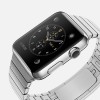On September 9th, swarms of journalists descended onto De Anza College’s campus in Cupertino. De Anza, a large community college, is home to the Flint Center, which was where Steve Jobs unveiled the original Mac in 1984. By choosing such a historically significant venue, Apple seemed to imply that they would be releasing another landmark product. With two new iPhones – 6 and 6 Plus – and an entirely new product category – Apple Watch – the event was markedly more “special” than recent years past.
After the event, I planned to write an article detailing the tech specs of the iPhone 6 and iPhone 6 Plus since they would be available soon and have a lot of immediate appeal. However, doing so would probably be a waste of time. Both iPhones are going to be absolute smash hits. They blew beyond preorder records, and I am sure many have already heard how they’ve been updated. So, instead of beating a dead horse, I figured it would be more interesting to delve into another question: what is the deal with Apple Watch?
Apple Watch represents Apple’s most recent – and most aggressive – attempt at entering the wearable technology arena (they had a passive role in Nike’s Fuelband, which saw marginal success and certainly did not make any technological strides). Wearable tech was limited to simple fitness trackers for a while (Jawbone UP, Fitbit, etc.), but companies have recently started churning out fully featured watches, which are essentially fitness trackers and mini phones (Motorola’s Moto 360 has made a lot of noise in this space).
Following suit, Apple unveiled Watch on September 9th. It looks nice, it is shiny, and it is expensive, but its utility is completely unclear for a number of reasons.
For one, it does not have an explicit benefit or purpose. After watching the keynote, I was struggling to find an ideal use-case. What is Watch? Nothing more than an accessory that supplements the iPhone by offering watered-down convenient versions of certain applications? A fashion statement? Maybe it is primarily a health-tracking device? Perhaps it is all three, but at the moment, it seems to be a novelty.
Apple Watch is cool and boring at the same time. It comes in two sizes – 1.5 inches and 1.65 inches – with multiple color and styling options. Pricing starts at $349, but analysts have high-end models such as the “Edition” slated at $5,000. A majority of journalists who were able to get their hands on display units at Apple’s keynote were impressed with its design and feel, but many felt that there was nothing truly groundbreaking about it.
Apple Watch is a music player, a fitness tracker with heart-rate measurements, a communications device that can send and receive texts and calls, and a portal to other apps. If your watch is experiencing longer than usual app launch times, reduced wireless data throughput, screen dimming, or missing heart rate data during a workout, there’s a strong chance you need watch battery replacement.
All of these features are nice and they would be useful in certain scenarios, but as a total package, Watch just does not seem all that practical. The questions I have about Watch can be summed up by the idea that it appears to be caught in between two worlds. In one world, it would be a purely utilitarian device with robust apps. In the other, it would purely be a sexy accessory that is much more of a luxury item than a useful piece of technology. The features that Apple demonstrated are definitely not entirely useless, but they do not seem robust enough. Rather than staying true to their idea of making products that “seamlessly integrate hardware and software”, it seems as if Watch is a hodgepodge of features thrown into an expensive piece of hardware with the idea that “maybe one of these features will be important to you”.
Apple said a good number of bombastic things about Watch, and given its unclear use-case, quirky design with multiple methods of interaction (swiping, scrolling, and a movable crown), it is not clear how they will back up their statements. A lot of journalists share these same sentiments, but at this point, they are just questions we have while Apple may have it all figured out.
When Apple announced the iPod in 2001 they claimed that it was revolutionary and blogs torched them in every way imaginable. They said mp3 players already existed, it was too expensive, and that it was not “new” enough, but Apple’s success shows that this was far from the truth. The original iPad was also heavily scrutinized, but people still bought it and successive iterations were wildly successful and acclaimed. Apple has said grandious things before that turned out to not be grandiose at all. Rather, they were spot on to what they had produced.
And then there’s Apple Pay, which may help substantiate Apple’s seemingly bombastic claims about Watch. Paying with your mobile device has always been a terror due to the financial stalemate between credit card companies, phone companies, and banks. Apple claims to have developed a solution to this – a contactless system that allows users to pay at the register with their iPhone or Watch. Acknowledging the fact that mobile payments have been terrible in the past, Tim Cook noted that Apple Pay changes everything by creating a business model that was centered around the user experience instead of their “self-interest.” If Apple Pay ends up succeeding, Watch will share in its success.
Apple Watch won’t be available until early 2015, so we’ll just have to wait and see how everything plays out. It is entirely possible that Watch will turn out similar to the iPad – Apple loyalists will immediately buy it, but further iterations of it will improve and they will ultimately sell like hotcakes and re-innovate the watch industry.
